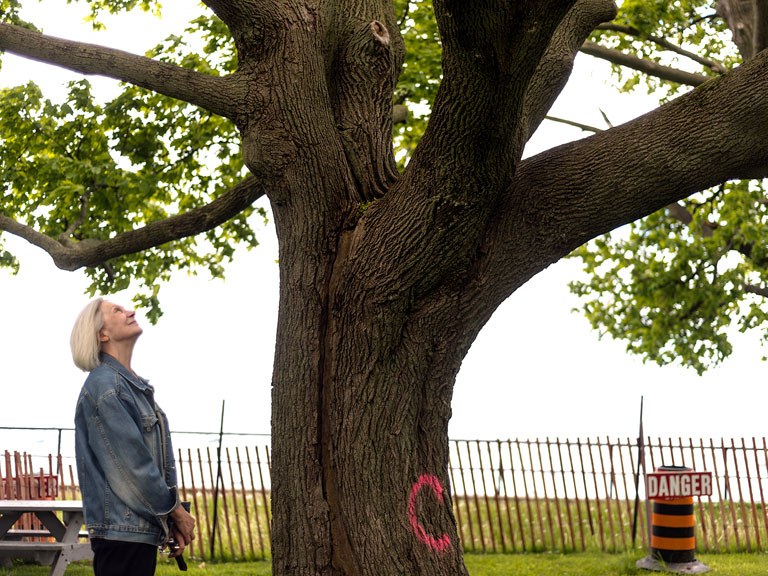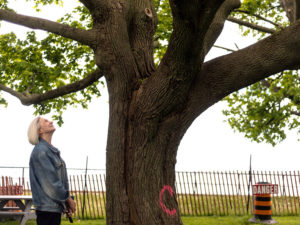County News
Wooden nickels

Staff is trained to manage trees, but is it enough?
Gerry Jenkison loves trees. She has since she was a child. When her children were young, she learned the names and traits of trees so she could impart that knowledge.
The majesty of a being that has the power to give other living things so much—food, shelter, clean air—and that stands, an observer to the world over decades, centuries, sometimes a millennium, fills her, and many others, with awe.
Today, Jenkison’s children are grown, but her love of trees has not faded. The artist and member of the County’s Horticultural Society is one of two women who convinced council earlier this year to strike a committee including members of the Prince Edward Field Naturalists, the Horticultural Society and the Master Gardeners, along with representatives from municipal staff and council, to help shape the County’s tree policy. It’s a document that determines how trees are maintained, and determines who decides whether a tree has to be cut down. In 2015, council asked staff to develop a modernized policy.
“It’s not going the way we would like it to yet,” says Jenkison. “We’d like to stress preservation over cutting. When trees absolutely must be cut down, we’d like to see replacement trees.”
The fall will have arrived before that committee forms. In the meanwhile, bright pink Cs have been spray-painted on nearly 200 trees in the County that staff have determined should be cut down. That includes two mature maple trees situated at the south end of the park in Wellington.
In April, a request for proposals was released to hire contractors who would remove them.
Many of those trees pose a safety risk. They’ve reached the end of their lives, and their heavy branches can only hold up so long before they come crashing down. But while they are provided with training courses on tree maintenance and removal, the staff members who have spraypainted those Cs are not trained arborists.
It means some trees that are slated for removal could be mistakenly identified as dead or dying. With proper maintenance, those are trees that could potentially be kept intact safely for years.
In a recent meeting of a committee of council, public works commissioner Robert McAuley told councillors that while the municipality has not hired an arborist, staff is trained to manage trees on municipal property.
“They attend professional courses on street tree management and tree health determinations through the Ontario Good Roads Association (OGRA) and the Association of Ontario Roads Supervisors (AORS),” McAuley told council. “We send two or three individuals, approximately every year. They are shown how to determine health, safety, other aspects. How to properly tend the tree; take the tree down, these kinds of matters. But it’s not an arborist course; it’s a tree management course.”

Gerry Jenkison examines a maple tree at Wellington Park marked with a ‘c’ for cut.
Heather Crewe, who manages education and training for the OGRA, says that there is only one course in which trees are mentioned. The T.J. Mahony Road School for municipal roads management includes a section that helps determine when to remove trees on or near roadways. Reasons include roots damaging pavement or underground infrastructure, trees being in the way of necessary road or sidewalk widening and removing dead or diseased trees that may cause damage or injury.
“The only reference we do make to trees specifically is in reference to trees that fall within the road’s right of way,” says Crewe. “Primarily, the factor in whether or not if that tree within the right of way has to come down would be based on safety. Does the tree pose a hazard? Is the tree dead or diseased? When you have a brittle dead tree and there’s the potential of an ice storm, then the trees can come down and cause unbelievable havoc.”
The course does not detail how to identify whether trees are diseased or dying.
Dennis O’Neil, who provides member services for the AORS, says that group offers a two-day course on the safe use of chainsaws for felling trees.
“This is the only course we offer for chainsaw operation and it teaches students how to safely remove trees. It is not intended to replace the work of an arborist,” O’Neil elaborated.
There is another association that provides training services to municipal clients, the Ontario Recreation and Facilities Association, and that association offers courses that help staff identify trees that may no longer be safe in municipal parks and forests. It’s not clear if the County is a client of this association.
Jenkison is unimpressed by McAuley’s implication that the training is sufficient to protect mature trees.
“The very title, roads maintenance, suggests utility rather than conservation and preservation, for trees with profound value to the community and to the atmosphere,” she comments.
At the meeting, some councillors expressed concern. Ameliasburgh councillors Janice Maynard and Dianne O’Brien asked about why trees, especially on shorelines, were being marked for cutting, and whether there would be a moratorium on those trees.
Picton councillor Lenny Epstein was concerned about the public’s perception of the process.
“We need to make an effort to build confidence in the public that these decisions are sustainable and that we recognize the value, especially of mature trees,” Epstein told McAuley. “There are a lot of benefits to mature trees. I appreciate that there may be a one-off course every year, but we don’t seem to have dedicated, long-term expertise looking at these trees, and I think that that would be something that would help build confidence in the public that all of the trees in any given year slated to be cut down should be cut down.”
Epstein pointed out that since there is only enough room in the budget to replace about 20 of the trees that will be cut down, saving mature trees is imperative. He thinks the public’s interest could mean protection for the trees even if an arborist is not involved. Following the meeting, he released a list of trees slated to be cut, all already listed on the publicly available request for proposals.
He asked the public to be “tree detectives,” and contact him if they see a tree on the list that should not be cut down.
“The majority of them likely do need to be cut down. They do reach the end of their lives,” says Epstein. “Trees are one issue which consistently comes up… we have a whole bunch of citizens who care a lot about it, and trees are a great opportunity for the municipality to get into using the power of the crowd to help up with the inventory of trees, care, maintenance. There are a lot of eyes and hands willing to help.”
Jenkison hopes Epstein’s list will help until the policy is updated.
“I’m a realist. In an ideal world, I would like it to start really soon, but I recognize that you have other priorities, and they’re all busy. I certainly would like that list evaluated… I’d like to see this process slowed down.”

Only enough room in the budget to replace 20 trees, but room to cut down 200! Sounds like a decision made by council and staff, not something based on room!
If council and staff choose cutting as the priority and one day of training is deemed acceptable then it is no surprise that preservation cannot happen. Trees are not grass, the weekly or yearly use of a chainsaw is not management, removal is the last piece of urban forest management.